![]() The Outline view represents the map as a hierarchical list which you can expand and collapse as required. It allows easy navigation through the document from top to bottom and gives you another way to brainstorm ideas.
The Outline view represents the map as a hierarchical list which you can expand and collapse as required. It allows easy navigation through the document from top to bottom and gives you another way to brainstorm ideas.
It is particularly useful when building a task list, as you can view all the task properties in one glance and edit them quickly by clicking the relevant cell.
You can access the Outline view in different ways:
 To create a new outline from scratch, click the File tab and choose New | Outline.
To create a new outline from scratch, click the File tab and choose New | Outline.
To display an existing map in outline form in the Outline view, you can either:
 Choose Home | View | Outline or View | View | Outline in the main menu, or
Choose Home | View | Outline or View | View | Outline in the main menu, or
 Right-click the workspace and choose View Map as Outline in the local menu, or
Right-click the workspace and choose View Map as Outline in the local menu, or
 Press Ctrl + Shift + 5.
Press Ctrl + Shift + 5.
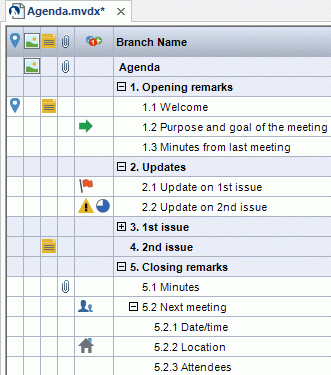
Going to the Outline view from another view only affects the way the mind map is displayed. The contents of the mind map are not modified, unless you edit them yourself while working in the Outline view.
![]() You can quickly switch map views by right-clicking the workspace and selecting the desired view in the floating toolbar that appears above the right-click menu.
You can quickly switch map views by right-clicking the workspace and selecting the desired view in the floating toolbar that appears above the right-click menu.
![]()
The Outline view shown above is made up of several columns:
 A bookmark icon
A bookmark icon ![]() in the first column indicates that the branch has been singled out using the Bookmark feature so that you can locate it quickly again within your map. For more information about this feature, see "Viewing a mind map".
in the first column indicates that the branch has been singled out using the Bookmark feature so that you can locate it quickly again within your map. For more information about this feature, see "Viewing a mind map".
 A picture icon
A picture icon ![]() in the next column denotes the presence of a branch picture. Just move the pointer over the icon to see a preview of the picture. Double-click the icon to display the picture in the image viewer associated with its file extension on your computer.
in the next column denotes the presence of a branch picture. Just move the pointer over the icon to see a preview of the picture. Double-click the icon to display the picture in the image viewer associated with its file extension on your computer.
 A yellow comment icon
A yellow comment icon ![]() in the next column indicates that the corresponding branch contains a pop-up comment. Just move the pointer over the icon to open the comment window.
in the next column indicates that the corresponding branch contains a pop-up comment. Just move the pointer over the icon to open the comment window.
 A paperclip icon
A paperclip icon ![]() in the next column indicates that the corresponding branch contains attached objects (text notes, text files, video files and so on) or that it is linked to another branch via a branch connection. To view an attached object, move the pointer over the icon to display the pop-up list of attached objects and click the required object to open it in the associated viewer.
in the next column indicates that the corresponding branch contains attached objects (text notes, text files, video files and so on) or that it is linked to another branch via a branch connection. To view an attached object, move the pointer over the icon to display the pop-up list of attached objects and click the required object to open it in the associated viewer.
 If you have inserted one or more icons on the corresponding branch, these are shown in the last column before the branch name.
If you have inserted one or more icons on the corresponding branch, these are shown in the last column before the branch name.
 By default, the columns on the right of the view show the Start and End dates you can associate with the branch to describe a task, as well as its Priority, Completion level and Resources. See "Inserting task data" for details about these fields.
By default, the columns on the right of the view show the Start and End dates you can associate with the branch to describe a task, as well as its Priority, Completion level and Resources. See "Inserting task data" for details about these fields.
 If you are working on a project plan, a Duration column also appears, as well as columns labeled Work and Cost. See "Using the Gantt view" for more information about project plans.
If you are working on a project plan, a Duration column also appears, as well as columns labeled Work and Cost. See "Using the Gantt view" for more information about project plans.
 If you are working on a timeline, the columns on the right of the view show the Start Time and End Time associated with each timeline event. See "Inserting timeline data" for details about these fields.
If you are working on a timeline, the columns on the right of the view show the Start Time and End Time associated with each timeline event. See "Inserting timeline data" for details about these fields.
You can hide and show the columns of the Outline view as you wish:
 Click the Outline Tools tab.
Click the Outline Tools tab.
 Choose View | Columns.
Choose View | Columns.
 Select or deselect the column headers as required.
Select or deselect the column headers as required.
![]() You can also right-click the header at the top of the Outline view and select/deselect the column headers as required.
You can also right-click the header at the top of the Outline view and select/deselect the column headers as required.
MindView lets you change the order of the columns by simply dragging and dropping them as needed.
 Click the header of the column you want to move, and hold down the left mouse button.
Click the header of the column you want to move, and hold down the left mouse button.
The mouse pointer changes shape ![]() to indicate that the column can be moved.
to indicate that the column can be moved.
 While keeping the left mouse button down, drag the column left or right to the required location.
While keeping the left mouse button down, drag the column left or right to the required location.

A vertical black bar indicates where the column will be inserted when you let go of the mouse button.
MindView lets you apply different color schemes to your outline:
 To choose a different color scheme, click the Design tab and check the effect produced by the different options of the Color Scheme gallery before clicking your preferred option.
To choose a different color scheme, click the Design tab and check the effect produced by the different options of the Color Scheme gallery before clicking your preferred option.
You can add and delete main branches, pre-branches and sub-branches in the Outline view in just the same way as in the Map views.
You can move an entire branch, including any sub-branches and objects attached to it, to a different branch of your outline. As you work on organizing your ideas, you can for instance decide to convert a sub-topic to a main topic by moving the corresponding sub-branch to the root, or allocate a sub-topic to a different main topic by moving the corresponding sub-branch to a different main branch.
 Select the branch you want to move to a different location by clicking it with the left mouse button.
Select the branch you want to move to a different location by clicking it with the left mouse button.
 While keeping the left mouse button down, drag the branch to the required location.
While keeping the left mouse button down, drag the branch to the required location.
The mouse pointer changes to a different shape to show you where the branch will be inserted when you let go of the mouse button.
In the example below, dropping the "Planning" branch at the position shown in red by the Move icon ![]() will make it a sub-branch of the "Discussion" branch.
will make it a sub-branch of the "Discussion" branch.
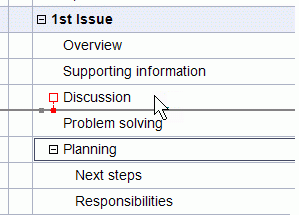 =>
=> 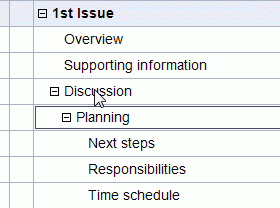
Dragging the "Planning" branch to the left until the Move icon reaches the left dot will keep it at the same hierarchical level (i.e. as sub-branch of "1st Issue") and insert it between "Discussion" and "Problem solving".
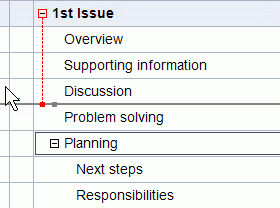 =>
=> 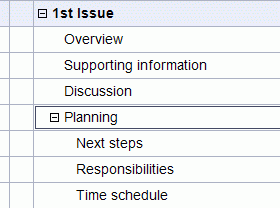
 You can also choose the Indent icon
You can also choose the Indent icon ![]() of the Outline Tools tab (or press the keys Alt + Shift + right arrow) to move the selected branch or branches to the next level down in the hierarchy, so that they become sub-branches of the preceding branch in the Outline.
of the Outline Tools tab (or press the keys Alt + Shift + right arrow) to move the selected branch or branches to the next level down in the hierarchy, so that they become sub-branches of the preceding branch in the Outline.
 Conversely, you can choose the Outdent icon
Conversely, you can choose the Outdent icon ![]() (or press the keys Alt + Shift + left arrow) to move the selected branch or branches to the next level up in the hierarchy.
(or press the keys Alt + Shift + left arrow) to move the selected branch or branches to the next level up in the hierarchy.
 Finally, you can choose the Move Up
Finally, you can choose the Move Up ![]() and Move Down
and Move Down ![]() icons (or press the keys Ctrl + Up or Ctrl + Down) to move the selected branch up or down within the same level.
icons (or press the keys Ctrl + Up or Ctrl + Down) to move the selected branch up or down within the same level.
You can apply the standard Cut, Copy and Paste functions to any branch or set of branches of your outline, as described in "Moving a branch". You can for instance copy or move an entire branch or set of branches, including all their sub-branches and attached objects, to a different part of the outline, at the same hierarchical level or at a higher or lower level.
To perform these operations on a set of branches, you first need to select them:
 To select a range of branches listed one after the other, select the first branch, press and hold down the Shift key and select the last branch in the range.
To select a range of branches listed one after the other, select the first branch, press and hold down the Shift key and select the last branch in the range.
 To select several isolated branches, select the first branch, press and hold down the Ctrl key and select the other branches one by one.
To select several isolated branches, select the first branch, press and hold down the Ctrl key and select the other branches one by one.
You can add branch pictures, icons, text notes and pop-up comments on a branch in the same way as in the Map views. For more information on these procedures, see the topics "Inserting pictures", "Inserting icons", "Inserting text notes" and "Inserting comments" in the "Basic tasks" section.
You can also attach objects such as text files, video files, sound files, hyperlinks and so on just as in the Map views. For more information, see "Attaching objects" and "Creating hyperlinks".
There are however some limitations that apply when you work in the Outline view:
 You cannot add or view floating pictures.
You cannot add or view floating pictures.
 You cannot add or view floating comments.
You cannot add or view floating comments.
 You cannot create branch connections, although existing branch connections are listed in the pop-up list identified by the paperclip icon and can be activated from that list.
You cannot create branch connections, although existing branch connections are listed in the pop-up list identified by the paperclip icon and can be activated from that list.
 You can choose the text size to be used in the Outline view by clicking one of the Text Size icons of the Outline Tools tab.
You can choose the text size to be used in the Outline view by clicking one of the Text Size icons of the Outline Tools tab.
![]()
 You can show or hide the text notes associated with each branch in the outline itself by choosing View | Show Text Notes in the Outline Tools tab. Longer text notes can be scrolled up and down by clicking the small icons
You can show or hide the text notes associated with each branch in the outline itself by choosing View | Show Text Notes in the Outline Tools tab. Longer text notes can be scrolled up and down by clicking the small icons ![]() shown at the bottom of the note.
shown at the bottom of the note.
 You can expand or collapse a particular branch or set of branches by clicking the small plus
You can expand or collapse a particular branch or set of branches by clicking the small plus ![]() and minus
and minus ![]() signs on the left of the branch name or by pressing the keys Ctrl + right arrow to expand and Ctrl + left arrow to collapse.
signs on the left of the branch name or by pressing the keys Ctrl + right arrow to expand and Ctrl + left arrow to collapse.
 The Numbering Scheme icon
The Numbering Scheme icon ![]() of the Outline Tools tab or Home tab lets you apply sequential numbers to the branches of the outline and choose between various numbering styles.
of the Outline Tools tab or Home tab lets you apply sequential numbers to the branches of the outline and choose between various numbering styles.
 As in all the other views, the Detail Level icons
As in all the other views, the Detail Level icons ![]() of the View tab let you collapse the entire outline to just one level of branches, two levels, three levels or four levels. To show all the branches down to the last level, click the Show All Levels icon
of the View tab let you collapse the entire outline to just one level of branches, two levels, three levels or four levels. To show all the branches down to the last level, click the Show All Levels icon ![]() .
.
![]() You can also press Ctrl + 1 to display just one level of branches, Ctrl + 2 to show two levels etc. Ctrl + 5 shows all levels.
You can also press Ctrl + 1 to display just one level of branches, Ctrl + 2 to show two levels etc. Ctrl + 5 shows all levels.
 As in the other views, you can use the Apply Branch Focus icon
As in the other views, you can use the Apply Branch Focus icon ![]() of the View tab to restrict the display to a particular branch. Click the Clear Branch Focus icon
of the View tab to restrict the display to a particular branch. Click the Clear Branch Focus icon ![]() to view the entire outline again.
to view the entire outline again.
For more information about this procedure, see the topic "Focusing on a branch" of the "Further tasks" section.
 Finally the Filter icon
Finally the Filter icon ![]() of the View tab lets you hide all the branches of the outline that do not meet the filter criteria you have defined. You can also use the Highlight icon
of the View tab lets you hide all the branches of the outline that do not meet the filter criteria you have defined. You can also use the Highlight icon ![]() to highlight branches that meet the filter criteria but still keep the rest of the branches visible.
to highlight branches that meet the filter criteria but still keep the rest of the branches visible.
For more information about this procedure, see the topic "Filtering a mind map" of the "Further tasks" section.
You can print your outline in the same way as in the Map views.
For a full description of the printing options available, see "Printing a mind map".